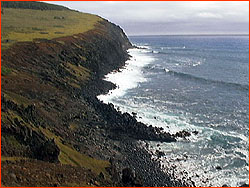
|
 |
 |
 Arrival on Rapa Nui
Arrival on Rapa Nuiby Liesl Clark April 17, 1998 Nothing can prepare you for a place like this—a tiny speck of land that sits in the middle of the South Pacific and is a 5-hour plane ride from anywhere else on Earth. Green grass volcanic craters rise up from low-lying hills covered with millions of basalt lava rocks rounded with time. Several volcanic explosions left this island littered with black debris. The terrain looks inviting, but to walk across it is nearly impossible. The stones cripple you with their large marble-like shapes: better to stick to the dirt roads, which are now soupy from a week of rain. We left Boston on Easter Sunday to travel to the island which was named "Easter" on this very day back in 1722, by a Dutchman who was the first European to sail here. The islanders call their home "Rapa Nui," which some locals say means "big barren land." Surf pounds the black rock coastline and breathtaking views from the hills above inevitably draw your eye toward the flat infinite horizon, beyond which the so-called "rest of the world" lies. We're here to learn how the ancient Easter Islanders moved and raised the many-ton statues of human heads, called "moai," all over the island. Most lie on the ground, either abandoned in mid-transit, or pushed over by time, weather, and early islanders caught up in regional warfare. Everyone here has a theory on how the moai were moved and raised, and no two theories are alike. Some are based on archaeological evidence and others come from the heart. We'll be here a month and I'm already convinced we'll just barely scratch the surface of this great island in our quest to find methods that are viable possibilities. We welcome all theories, but will only have time to try out a few. With a team of Chilean, American, and Rapanui archaeologists, along with a large sampling of the island community (there are 2,000 in all), we will move and erect a 15-ton replica moai. The challenge is to limit ourselves to the same materials used by the early islanders: wood, rope, human power, and maybe sweet potatoes or bananas for lubrication. Every day spent here raises more questions; were the moai transported lying down or standing up? If lying down, were they face up or down? Head first or base first? Were they dragged, rocked, or rolled? Did they approach the platforms from the front or from behind? We'll be here a month, and I tend to think the secrets of this island will remain locked behind the silent gaze of these stone monuments—well beyond our departure. "But, let them have been made and put up, by this or any other method," wrote Captain James Cook when he visited Easter Island and theorized on how the moai were moved and raised, for "they must have been a work of immense time, and sufficiently show the ingenuity and perseverance of the islanders in the age in which they were built." Lessons Learned (May 11) A New Way to Move a Moai (May 9) Moai is Upright (May 6) Moai Nearly Raised (May 5) A Tourist Attraction (May 3) The Secret of the Sledge (May 2) Moai Ready to be Raised (May 1) The Moai is Moved (April 30) 15-Ton Moai Removed from Mold (April 27) Moai Platform Complete (April 26) Moai Mold is Filled (April 24) Moai Mold Ready for Concrete (April 23) Statue Mold En Route (April 22) The Team Arrives (April 20) Arrival on Rapa Nui (April 17) Photo: Liesl Clark Move a Megalith | Dispatches | Explore the Island | Lost Civilization Resources | E-mail | Table of Contents | Easter Island Home Editor's Picks | Previous Sites | Join Us/E-mail | TV/Web Schedule About NOVA | Teachers | Site Map | Shop | Jobs | Search | To print PBS Online | NOVA Online | WGBH © | Updated November 2000 |